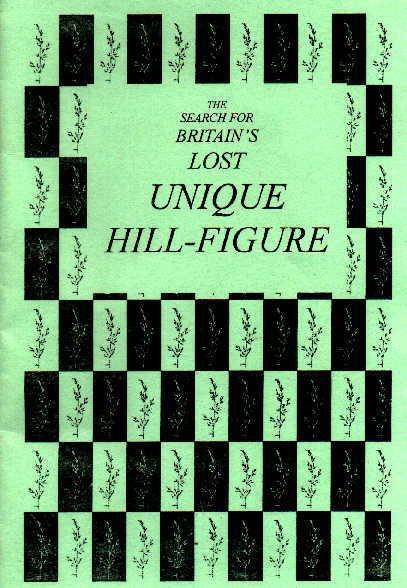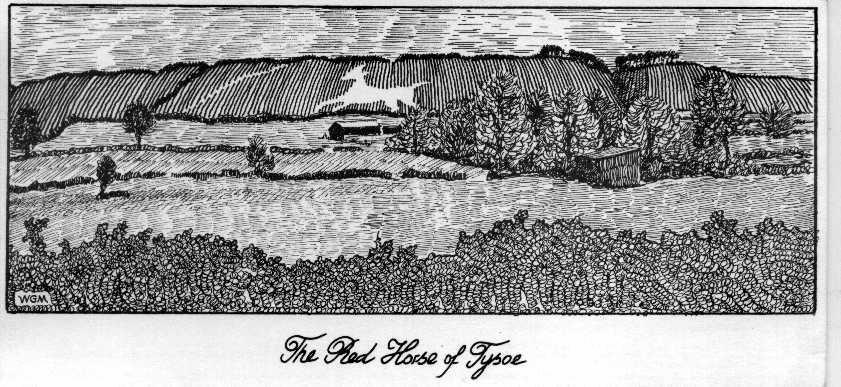
The Red Horse of Tysoe is the name given to the figure of a horse that used to be cut onto the hillside above the village of Tysoe in Warwickshire, England. The turf had been cut away to expose the ruddy coloured soil beneath, in the shape of a galloping or leaping horse. The figure is no longer visible today as it has been allowed to grass over by successive generations of local villagers and landowners and the actual site , a slope of some 30 degrees has been planted with softwood trees, completely obscuring any visible trace of the figure. However, the Horse was at one time famous enough to cause the area to be known as 'The Vale of the Red Horse.'See map 1
The history of the Red Horse has been researched in some detail by Mr Kenneth Carrdus and Mr Graham Miller during the 1960's and 70's and it was these gentlemen who, using ariel photographs, rediscovered the site of the original Horse before it was planted with trees. Much of the information here is from their booklet "The Red Horse of Tysoe" published in 1965 and now long out of print (see update below).
The name of Tysoe has been suggested as meaning 'Tiw's hoh' which means a spur of land dedicated to the God Tiw, an Anglo-Saxon God of war. Legend connects Tiw with the binding of an evil beast, ie. a story of the triumph of good over evil and it may be that the original Horse dates from the Saxon period, cut by them perhaps to commemorate a victory. There is ,however little hard evidence to prove this dating. Certainly some other Hillfigures such as the Uffington Horse and the Cerne Giant do have some greater antiquity and it is not impossible, therefore that the Red Horse does date from the Dark ages.
The earliest documentary evidence for the existence of the Horse is from 1606 when cartographer John Speed, talking of Warwickshire mentions the 'Vale of the Red Horse'. In 1607 the figure itself is mentioned in Camdens' 'Brittania'.
".... and a great part of the very Vale is thereupon termed the Vale of the Red Horse, of the shape of a horse cut out in a red hill by the country people, hard by Pillerton."
Sir William Dugdale who was commissioned to record the nations treasures during the Civil war may have seen the Horse when at the Battle of Edgehill in 1642.
"Within the precinct of the Manor of Tishoe now belonging to the Earl of Northampton, there is cut upon the side of Edgehill the proportion of a horse in very large form; which by by reason of the ruddy colour of the earth is called the Red Horse and giveth denomination to that fruitful and pleasant country thereabouts, commonly called the Vale of the Red Horse: the trenches of which ground where the shape of the said Horse is so cut out, being yearly scoured by a Free-holder in this Lordship who holds certain land there by that service"
'Scouring' is the name given to the annual, (or in some cases every seven years) cleaning of the weeds and grass that had obscured the figure. It may be that Dugdale actually saw what was left of the Saxon figure. Some have suggested taht the Horse dates from this period and may have been cut after the Battle of Edgehill but earlier references disprove this theory. It seems certain that the Horse was already old by the Seventeenth century. After this period, it may be that the Horse became neglected and overgrown, so much so that it may have been completely gone by the middle of the next century. What may have happened ,however, is that persons unknown had cut at least one , if not two smaller figures very close to the original Horse. The Reverend Francis Wise says of the figure;
"........ vastly inferior to the Uffington Horse in every respect in it's design, dimensions, fabric and situation being hardly visible at a distance. The whole betrays itself to be the work of a later age and more rude workmen."
In 1756 Bishop Pocock stated that the Horse had it's 'tail held up' and in 1806 Richard Gough published some dimensions in Camdens Brittania;
"..........croup to chest, 34 feet; shoulder to ears, under jaw to bottom of chest, 10 feet; shouder to ground, 16 feet or 57 hands; length of off foreleg, 12 feet; length of near foreleg,9 feet; hindlegs , 10 feet ; belly, 19.5 feet; sheath, 8 feet; tail (more like a lion's) , 18 feet; width of each leg 1 foot; diameter of the eye, 1 foot 2 inches long."
It seems that this figure was very much smaller than the 'Horse in a very large forme' seen by Dugdale As Carrdus and Miller point out in their booklet, if Camden in 1607 had been on the Fosse way by Pillerton which is some 4 miles from Tysoe, and the Horse was visible at this distance, then it must have been very much larger than the Eighteenth century figure.
What does appear in documents belonging to the Marquess of Northampton are papers showing that the Horse old and new was put in charge of the Tennants of Dinsdale Farm and later Red Horse Farm (below the site). It was presumably their responsibility to scour the Horse on a regular basis.
It appears that when a Mr Simon Nicholls bought Sunrising House (on the A422 main Banbury road) in 1800 he ploughed up the existing Horse . However on finding that he was loosing money ,the property was formerly an Inn, he cut another figure near to his house an attempted to revive festivities around the new figure. In 1842 it's measurements are given as 18 feet (long?) and in 1892 as about 10 yards long. There seems some debate as to whether any Horse existed by 1906 and there was some moves to try to recut the figure at this time. The Landowner a Mr Savory was "exasperated at the number of visitors asking to see it " and obliterated all trace of this figure.
Mr Carrdus and Mr Miller both talked to local residents who could remember this small figure and yet another, created at some time just slightly South of Sunrising Covert. This new site is still some kilometer of more North east of the site of the original 'Saxon' Horse. (see map)
HARD EVIDENCE
In 1961 when Carrdus and Miller began the search for the Red Horse, they didn't even know exactly where it had been located. Maps of the Estate had not been good at pinpointing it's position. Photographs fron the ground and air failed to reveal any patterns in vegetation. In 1964 Mr Carrdus was given a map dated 1796 an this showed the Horse's position on Old Lodge Hill. Some excavation work was carried out but revealed no sign of long term scouring or earthwork.. Documentary evidence lead them to look at an area known as 'The Hangings' and Mr Miller took Photographs of the escarpment. These revealed "........ a white mark like a chess knight, the head and neck of a horse, directly above Old Lodge Farm on The Hangings." (Red Horse Farm).See photo The pattern made by the shading of vegetation was studied and observed for some months but it wasn't until air photographs were taken the following year that they revealed a complete figure 285 feet long and 195 feet high. The outlines of two successive figures cut nearby could also be discerned.See map 2
In the Autumn of 1967, a soil resistivity survey was carried out and the tests revealed higher readings from within the crop mark area than outside. This indicated that there had been soil disturbance at some time in the past, perhaps due to the regular scouring of the Red Horse. The testing confimed the details of the two ears and head, and at two further points, the position of the body. Excavation showed no visible changes to the soil and no rock sufficiently close to the surface to cause the changes in resistivity. Trenches dug to a depth of 30 inches and 'probes' to a depth of below 3 feet showed no rock, which would have to be within 2 feet of the surface to appreciably affect the survey.It was however, found that the depth of undisturbed clay was greater within the area of the figure. A further investigation was carried out during the Spring and Summer of 1969 in the area of the top of one of the ears, chosen because of it's complex shape. A second trench across the neck was also cut.
Due to the steep slope, it was necessary to find the clay line in the side of the trench. Alternatively, step trenches were dug and the clay line sought in the sides of the steps. The soil profile running down the slope could then be mapped. In the crop marked area it was found that the clay line was depressed by between 10- 28 inches below that ouside the mark. At some points, the division between soil and clay was found to be marked with vegetable matter, possibly grass and within the depressions the soil was found to consist of a brighter red silt than that above. An area of 'red infill' was found in the neck trench.
Carrdus and Miller then presented the evidence they had found in the documentary form of two reports. They suggested proof of the Horse's existence by the evidence they had uncovered. Firstly the documentary evidence and particularly the Enclosure map of 1896 which pinpointed the site of the Red Horse to the site currently under investigation. Secondly the crop marks visible on ariel photos. Thirdly the resistivity survey of 1967 and forthly the soil profile evidence they had just carried out.
In the late 1960's, The site of the Hangings was fast becoming overgrown with the new trees and despite petitioning the Owner, Lord Bearstead, he was not keen to destroy nearly two acres of maturing wood. Today the site is little changed. The more mature trees prevent under growth of vegetation and it is relatively easy to walk along between them. Traces of the original excavations from 1968 can still be discerned. The softwood trees are not likely to be harvested until around 2014 and Lord Bearstead's Grandson will probably taking responsibility for the estate in 2002. It can only be hoped he will consider the matter sypathetically if the Horse is ever to be recovered. When the trees are harvested, it is important that as little diturbance as possible occurs to avoid damaging the soil to any depth. Thanks to Kenneth Carrdus and Graham Miller, we at least know the precise location and history of this ancient hill figure.
THE SEARCH FOR BRITAIN'S LOST, UNIQUE HILL FIGURE (NOW UPDATED!)
The full story of the quest for The Red Horse can be found in a booklet by Graham Miller, fully updated Autumn 2000. Illustrated throughout with maps and photographs, it details the documentary and physical evidence uncovered by Graham Miller and the late Kenneth Carrdus.Essential for all students of Hill figures and their history, copies may be obtained from the address below;
Please send a cheque or postal order for £2.25.Overseas customers add £1.00 postage.(sterling only please)
TO.. W.G. & P. MILLER
HEATHERDENE
HOWEY
LLANDRINDOD WELLS
POWYS
WALES (UK)
LD1 5PN

This Web page was created by Steve Hamilton. If you want further information you can e-mail me. Click below;